Civil War (and Gore) News!
By Kurt Kuersteiner © 2011 Monsterwax
Monster Trading Cards
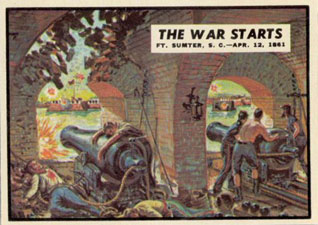
2011 marks the 150th anniversary of the start of the Civil War, the bloodiest war in American history. It also marks the 50th anniversary of the inception of one of the bloodiest (and most popular) card series from Topps: Civil War News. In light of both these historic anniversaries, now seems a good time to reconsider the war and the card set that chronicled it.
As a child of the early 1960s, I have two distinct memories relating to the Civil War. One was from a live television quiz show called I’ve Got A Secret, which ran on CBS until 1967. That series featured a celebrity panel that would try to determine a contestant’s “secret” (something that was unusual, amazing, or embarrassing). I remember watching an old man walk on stage and the panel asking him “yes” or “no” questions. They didn’t guess his secret, which was revealed to be that he was in the audience at Ford’s Theater the night Lincoln was shot. (He was a 2-year-old infant then, but lived to be over 100.) Just think about that: people who lived during the Civil War were still alive when we (the baby boomers) were growing up. That amazed me then and now.
My other Civil War memory was far more visual. Not old enough for grade school, I spent my days at home rummaging through my older brother’s room across the hall. He had all sorts of “cool stuff” stashed away in there. One day, I discovered a stack of gum cards with blood-soaked images of soldiers shooting, stabbing, and blowing each other up! If that wasn’t enough, there was also a stack of Confederate money, from $1 to $1,000 denominations. My ship had come in!
Naturally, the cards and money were both from the same source: Topps Chewing Gum company. The series was called Civil War, but collectors have essentially renamed it with the title of the newspaper herald on the back of each card, Civil War News. (Topps created the fake name because they received complaints when they used real newspaper heralds in an earlier series called Scoops.)
According to Len Brown, the Associate Creative Director at Topps, the series began in 1961 in response to all the publicity about the Civil War Centennial. He said that his boss, (Editor/ Art Director) Woody Gelman remembered another card series from 1938 called Horrors of War. The theory was that if a “blood & gore of war” series did well for Bowman 25 years earlier, then the same concept should work for Topps, too. It did. Civil War News (CWN) sold in all of Topps markets across the country, and even overseas in the UK, France, and Spain. It did so well that Topps gave the green light to Gelman and Brown to try the same formula again (bloody combat between armies) in two other art series (Mars Attacks in 1962, and Battle in 1965). So we owe both classics to CWN.
One of the things that made CWN so successful was the striking artwork. Norm Saunders, the master pulp cover artist of the 1930s, 40s, and 50s, had been toiling away painting updated jersey numbers on sports players in other Topps sets. For this tedious task, he was getting paid minimum wage ($1.15 an hour). The regular Topps artist was Maurice Blumenfeld, who was somewhat average in quality and slow on deadlines. (He also had problems with depression that led to suicide soon after Mars Attacks.) Because Topps wanted to cash-in on the 1961 Centennial hype, they knew they needed more help to finish the series on time. They invited Bob Powell (who drew their pencil guides and had a long career drawing The Shadow and other horror comics in the 1950s) and Saunders to help contribute paintings to the CWN. When they were all done, Saunders’ paintings so impressed the Art Department that he was asked to retouch the rest of the paintings and try to make them look as good as his. He spent a day at Topps with his paint box adding details and highlights to the other 75 pieces. The end result was that Blumenfeld originated a majority of the paintings (65 images), and Powell did 10 others, but Saunders did 13 plus a final polish on all 88. (See the detailed list of artist credits at Monsterwax.com/civilwar.html).
According to David Saunders, Norm’s son, his father was pleased that Topps finally appreciated his talent, but Norm also realized that by having him “touch up” the other artist’s work on an assembly line basis, they were only paying him a dime or quarter extra per painting, instead of hiring him to do the entire image. It also irked Bob Powell, who was an established comic book artist, to have his work “fixed” by someone else. Powell was the one who penciled all the layouts, and other artists were supposed to paint over his guides. But Saunders, with his many years of experience designing pulp covers, routinely “improved” those guides as well, irritating Powell even more!
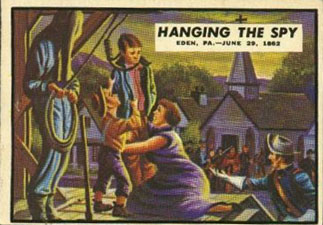
Some people feel the Topps cards are a historic embarrassment because the pictures are so bloody and the stories on the backs are mostly fictional. I feel the opposite. I think they capture the real pain and suffering of the war better than the “more dignified” Civil War sets that romanticize the era and glorify the war. Unlike those sets, the Topps series included numerous cards depicting the pain inflicted on the general public. Take for example the execution of civilians suspected of spying (#25, Hanging the Spy), which could occur when military tribunals sentenced suspects to death without much regard to evidence. The card shows it happening to a 15-year-old boy, and believe it or not, boys were executed in several occupied towns. Military kangaroo courts continued in the wake of the war as well, when Mary Surratt became the first woman ever hung by the Feds. Her crime? She owned the tavern where Lincoln’s assassins met, and she was the mother of an alleged conspirator (who was a fugitive but was later arrested, tried, and released). One of the real assassins cried out from the gallows as they were all waiting to drop to their deaths that he and his fellow prisoners were guilty, but that Mrs. Surratt was not. (She was hanged anyway.) A year later, the US Supreme Court ruled that all such military tribunals of US civilians were unconstitutional.
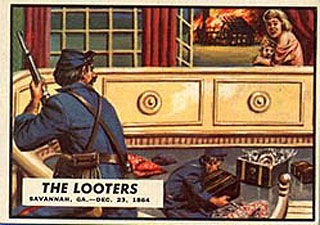
Another card depicts the looting of homes by Union soldiers (#83 The Looters). Although normally against the rules of military conduct, this practice was widespread among invading forces. General Sherman took it a step farther when he asked Lincoln for permission to burn homes, farms, and cities so as to “carve a pathway to the sea”. He argued it would cause economic chaos and demoralize the civilian population. This controversial policy would be considered a war crime by modern standards, but it worked well and brought the South to its knees. Sherman became a hero in the North and despised in the South. Cards #40 Protecting His Family, #70 The Sniper, #75 The Family Flees, and #80 City in Flames show the scheme carried out in burning color.
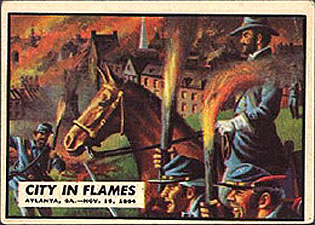
These types of gritty details are often ignored in other sets that focus on the gentlemanly aspect of the times. But the civil war was ferocious, and whatever the high ideals used to justify it, Americans never treated an enemy as cruelly as they did their fellow countrymen in that conflict. That’s truly tragic. The brutality of battle, as well as the pain and suffering that followed in its aftermath, are well represented in CWN. Just about every imaginable form of death is depicted, including most kid’s favorite card, the guy thrown from his horse and impaled on barricade stakes (#21 Painful Death).
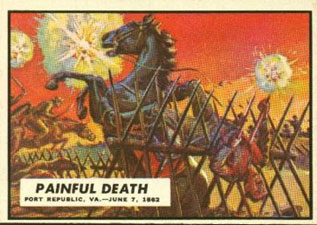
Perhaps the most terrible way to die was a form not shown in the set, but it was actually the most common cause, disease. A whopping 620,000 Americans died in the Civil War, more than all our other wars combined. Of that number, nearly 415,000 died of disease, which is over 2/3rds! Another 60,000 limped home with their arms or legs amputated. Card #58 Angel of Mercy tells about Clara Barton, a woman who nursed wounded soldiers back to health. It gives the impression that she helped both sides, but in reality, the Union maintained a blockade of food and medicines on the South. It was a decision that cost many Yankee POWs their lives. The poster child for this kind of needless death was Andersonville. The Confederate prison was overwhelmed with POWs and lost 13,000 to disease and starvation. That’s 28% of its inmates! Although less publicized, the North had similar results, with poor conditions in New York’s Elmira POW prison killing 25% of its inmates. Camp Douglas, located near The Wrapper headquarters in Chicago, withheld blankets and jackets to discourage escape attempts. 1 in 5 POWs froze or starved to death there (even though ample supplies were available).
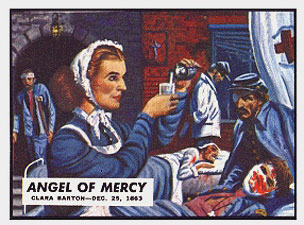
Despite similar mortality rates on both sides, the commandant of Andersonville was the only soldier executed for war crimes. The panel of military judges awarded the star witness a letter of accommodation for helping convict Captain Henry Wirz, since he was the only eyewitness to see Wirz kill a prisoner. That letter earned the witness a coveted job in the Interior Department. Meanwhile, Wirz was offered to have his life spared if he would implicate President Jefferson Davis in the prison’s atrocities. Wirz denied killing anyone and said he could never betray another man to save his own life. Eleven days after his execution, it was revealed that the star witness had lied about his identity and whereabouts during the war. He was in fact, a Union deserter and not a camp inmate. So even after the war, the camps still claimed lives!
My family had ancestors who served on both sides. The one who fought for the South was captured, and his wife traveled north to try to see him in prison. When she got there, she found out he had died from one of the many epidemics that plagued the prisoners, and many others were also dying. She stayed on as a volunteer nurse to try and help some of the other POWs recover (and hopefully, reunite with their families) but she ended up getting and dying from Typhoid. This left their only child an orphan. He was staying with relatives and grew up to become a doctor, motivated in part by wanting to prevent the kinds of sickness that killed his parents. The overall moral I picked up from these family stories was that it was not a glorious time, but a miserable time filled with grief and heartbreak for just about everyone.

Countless families lost their homes, their young men, and all they held dear. They suffered another ten years of angry occupation, followed by decades of damaged cities and a depressed economy. Yes, the lives of slaves were improved, but that was the only good part. When one considers the increasing speed of industrialization and cheaper immigrant labor, slavery was becoming economically obsolescent anyway (as it already had become in the North and other industrialized countries like England and France). Slavery could have and should have ended without unleashing the dogs of war and the wholesale carnage it caused. But that would have required some patience and compromise, something neither side was willing to grant their fellow Americans in order to avoid bloodshed. You would have hoped that if two sides ever had a decent chance of ironing out their differences diplomatically without resorting to war, it should have been the people who were already together in one country, sharing the same government, same language, same religion, and fought a revolution together.
Of course, the Topps card set doesn't get into any of that. It focuses instead on the sheer gore of war. And that aspect of the Civil War Topps emphasized better than any other card series before or since. In fact, the best way to describe the feeling one gets from reviewing Civil War News is the age-old adage, "War is HELL."